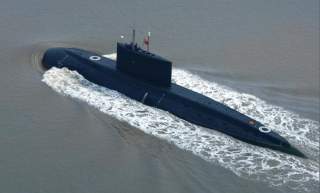Watch Out, India: China to Sell Pakistan 8 Submarines
Pakistan’s announcement represents a sea-change in Pakistan-China naval relations.
A couple of weeks ago, after a visit to India, I wrote an op-ed for the Indian weekly Open with my impressions of the Indian strategic debate. The biggest take-away was how openly suspicious the Indians are about China and its intentions in the Indian Ocean.
That suspicion got another boost yesterday, with Islamabad announcing that it has approved, in principle, the purchase of eight Chinese submarines for the Pakistani navy.
This is big news for a number of reasons. First, it's a large order for a navy that currently only operates five submarines. Second, it will be the first time China has exported its submarines, which says something about the improvements in its military technology (granted, Pakistan is probably buying on price as well as capability, but this is a navy that has previously bought advanced European submarines, so its not an undiscerning customer).
And third, it represents a fairly blunt Chinese statement about its willingness to cooperate with Pakistan to challenge Indian maritime power. Of course China has sold arms to Pakistan before, and in fact it helped Pakistan develop its nuclear and ballistic missile programs. China has also sold surface ships to the Pakistan Navy in the past. But in the maritime domain, it is fair to say that this is a step-change in China's involvement with the Pakistan military.
Things are likely to get even more discomfiting for India soon, with Xi Jinping set to visit Pakistan from April 10, where he will address parliament. The newspaper Dawn writes:
Sources say that during the visit, over two dozen memoranda of understanding (MOUs) regarding nuclear power, the Gwadar Port, the Pak-China Economic Corridor (PCEC), energy, trade and investment will be signed by Pakistan and China.
It will be interesting to hear what is announced on the Chinese-developed Gwadar Port, which has been cited in India as an example of Beijing's attempt to encircle India with naval bases, and also as a way for China to avoid maritime choke points in the Indian and Pacific oceans by moving Persian Gulf oil and gas over land from Gwadar to China. This theory has been debunked in the past, partly on the grounds that the port is not supported by sufficient road and rail infrastructure, but this might be set to change.
Sam Roggeveen is editor of the Lowy Interpreter, where this article originally appeared here.

